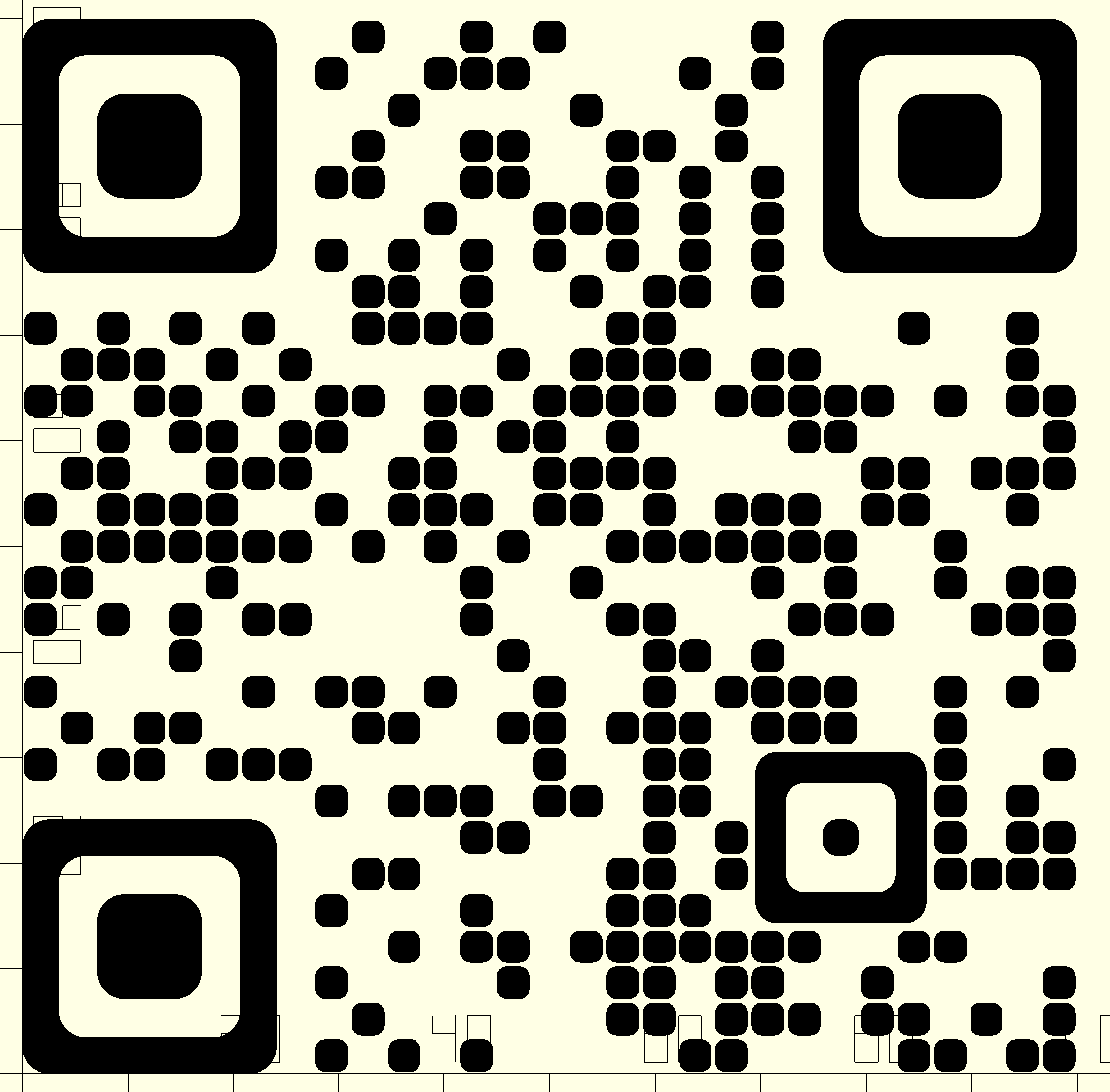Effortlessly generate QR codes directly in OpenSCAD! No extra dependencies!
This code...
include <qr.scad> // omit this if you pasted the library's source code at the end of the file
color("black") qr("https://github.com/xypwn/scadqr", center=true);...gives us this model
Click to expand
You can specify custom models for each module ("pixel"), position pattern and alignment pattern.
To do this, you can use the qr_custom() function.
See the API docs for all the details.
The following shows an example using round components.
include <qr.scad> // omit this if you pasted the library's source code at the end of the file
color("black") qr_custom("https://github.com/xypwn/scadqr") {
// Module
translate([0.5, 0.5])
scale([0.9, 0.9])
offset(r = 0.3, $fn=16)
square(0.4, center=true);
// Position pattern
translate([3.5, 3.5]) union() {
difference() {
offset(r = 0.75, $fn=32)
square(5.5, center=true);
offset(r = 0.75, $fn=32)
square(3.5, center=true);
}
offset(r = 0.75, $fn=32)
square(1.4, center=true);
}
// Alignment pattern
translate([2.5, 2.5]) union() {
difference() {
offset(r = 0.6, $fn=32)
square(3.5, center=true);
offset(r = 0.5, $fn=32)
square(2, center=true);
}
offset(r = 0.4, $fn=32)
square(0.2, center=true);
}
}Click to expand
You can generate special "messages" using the qr_wifi, qr_phone_call, qr_vcard etc. functions. The resulting message can be passed into the qr or qr_custom module as seen in the example below.
For more details, see API.md.
include <qr.scad> // omit this if you pasted the library's source code at the end of the file
color("black") qr(qr_wifi("MyNetworkName", "supersecretpassword1337"), center=true);Open qr.scad and click the "copy raw file" button...
 ...then paste the copied source code at the end of your project file.
...then paste the copied source code at the end of your project file.
Do NOT add the include <qr.scad> line if you are using this method!
This method is the only one that works with Thingiverse's Customizer.
If you're working with multiple source code files, I recommend using one of the other methods.
download the library file directly into your project folder and add an include <qr.scad> to the beginning of your file
Follow these instructions.
You will also have to add an include <qr.scad> to the beginning of your file
qr.scad (Right-Click -> Save target as)
This library fully supports Thingiverse's Customizer, but you will need to directly append the library code to your SCAD file, as Customizer only supports a single file.
I also noticed Customizer has some weird quirks regarding which SCAD code it will accept and which not. Here are some things you will need to pay attention to:
- NEVER use non-ASCII characters, or it will just say "We're sorry, but something went wrong."
- avoid functional asserts (e.g.:
function f(x) = assert(x > 0) x;) - some functions like
ord()aren't available
All scripts ending with .py require a recent version of Python.
You will also need to run them from inside the cloned repo's directory.
The source code is located in src/ and run through the generate.py script in order to generate the all-in-one library files intented to be used.
The generator script mainly does two things:
- Prefix private functions/modules with
_qr_to prevent naming collisions - Generate documentation for public functions/modules and output it to
API.md
Run generator (Linux/MacOS): ./generate.py
Run generator (Windows): py generate.py
To confirm that QR codes are generating correctly, you can run the automatic tests after having run generate.py.
Install OpenSCAD and ZBar
- Debian-based (e.g. Ubuntu, PopOS etc.):
sudo apt-get update && sudo apt-get -y install openscad zbar-tools - Arch-based (e.g. Manjaro):
sudo pacman -Sy openscad zbar --noconfirm - Windows: Download and run the respective installers for OpenSCAD and ZBar
Run tests (Linux/MacOS): ./run_tests.py
Run tests (Windows): py run_tests.py
If it can't find your OpenSCAD or ZBar executable, you can use the -s and -z options respectively to specify a custom path.
Copyright (c) 2024 Darwin Schuppan and contributors. All rights reserved.
This work is licensed under the terms of the MIT license.
For a copy, see https://opensource.org/licenses/MIT.

